GSBS6014 Digital Marketing Plan for Up Bank: Customer Growth
VerifiedAdded on 2021/08/23
|48
|9140
|47
Report
AI Summary
This digital marketing plan, prepared by BNCS.ORG for Up Bank, analyzes the competitive landscape, including the 'Big Four' Australian banks, and conducts a SWOT analysis to identify market opportunities. The plan focuses on two key objectives: acquiring 50,000 new customers within six months and enhancing service levels for existing customers. To achieve these goals, the report proposes four key campaigns: social media marketing (Facebook & Instagram ads), search engine optimization (SEO and AdWords), website conversion and engagement improvements, and multi-channel customer value creation. The plan includes detailed steps, timelines, a GANTT chart for implementation, and a budget of $424,116, including a 10% contingency. The plan targets specific customer segments ('Leading Lifestyles', 'Metrotechs', and 'Aspirationals') and details resource estimates, a schedule, and a plan review process. The report concludes with a recommendation for Up Bank to execute the proposed digital marketing plan to drive customer growth.
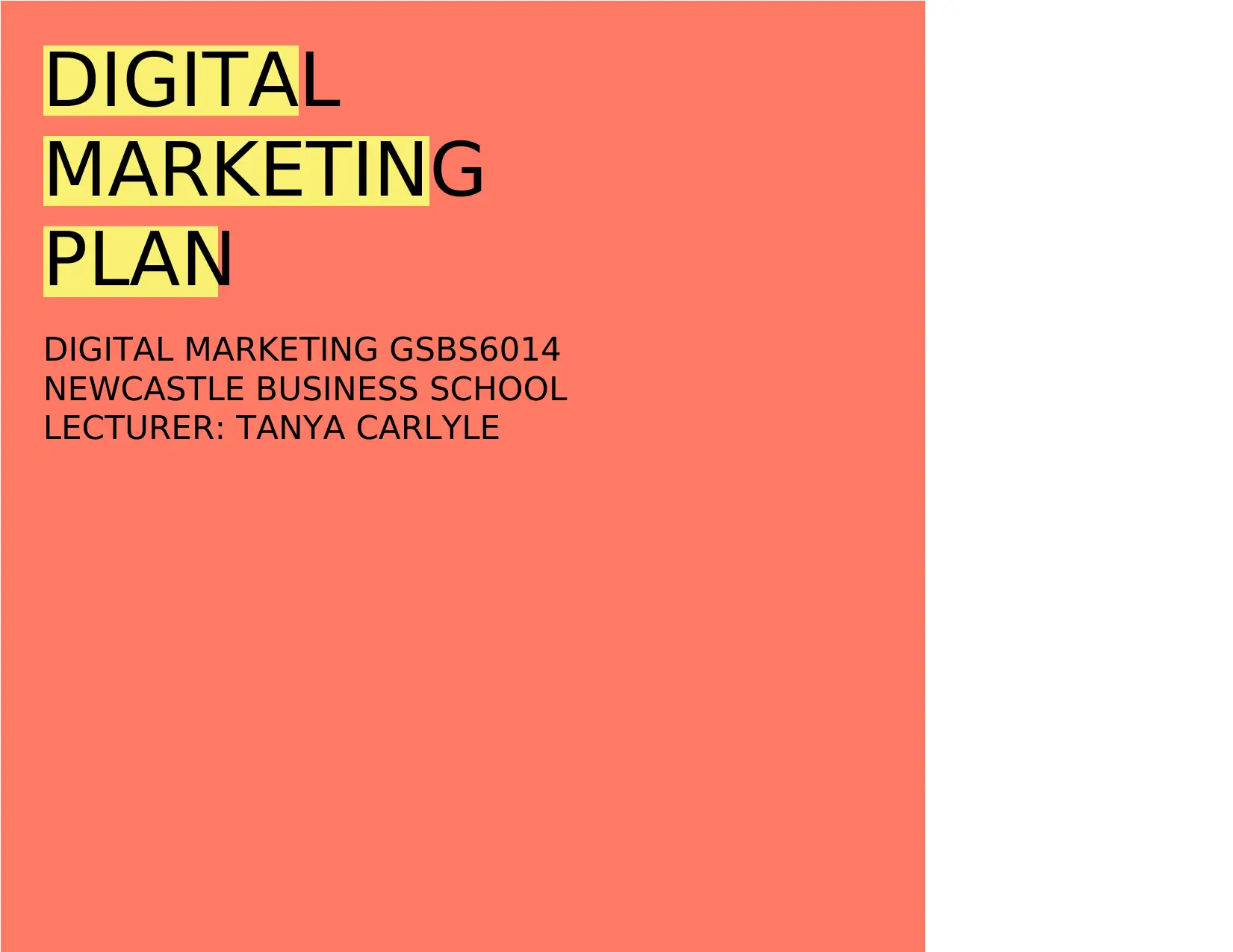
DIGITAL MARKETING GSBS6014
NEWCASTLE BUSINESS SCHOOL
LECTURER: TANYA CARLYLE
DIGITAL
MARKETING
PLAN
NEWCASTLE BUSINESS SCHOOL
LECTURER: TANYA CARLYLE
DIGITAL
MARKETING
PLAN
Paraphrase This Document
Need a fresh take? Get an instant paraphrase of this document with our AI Paraphraser

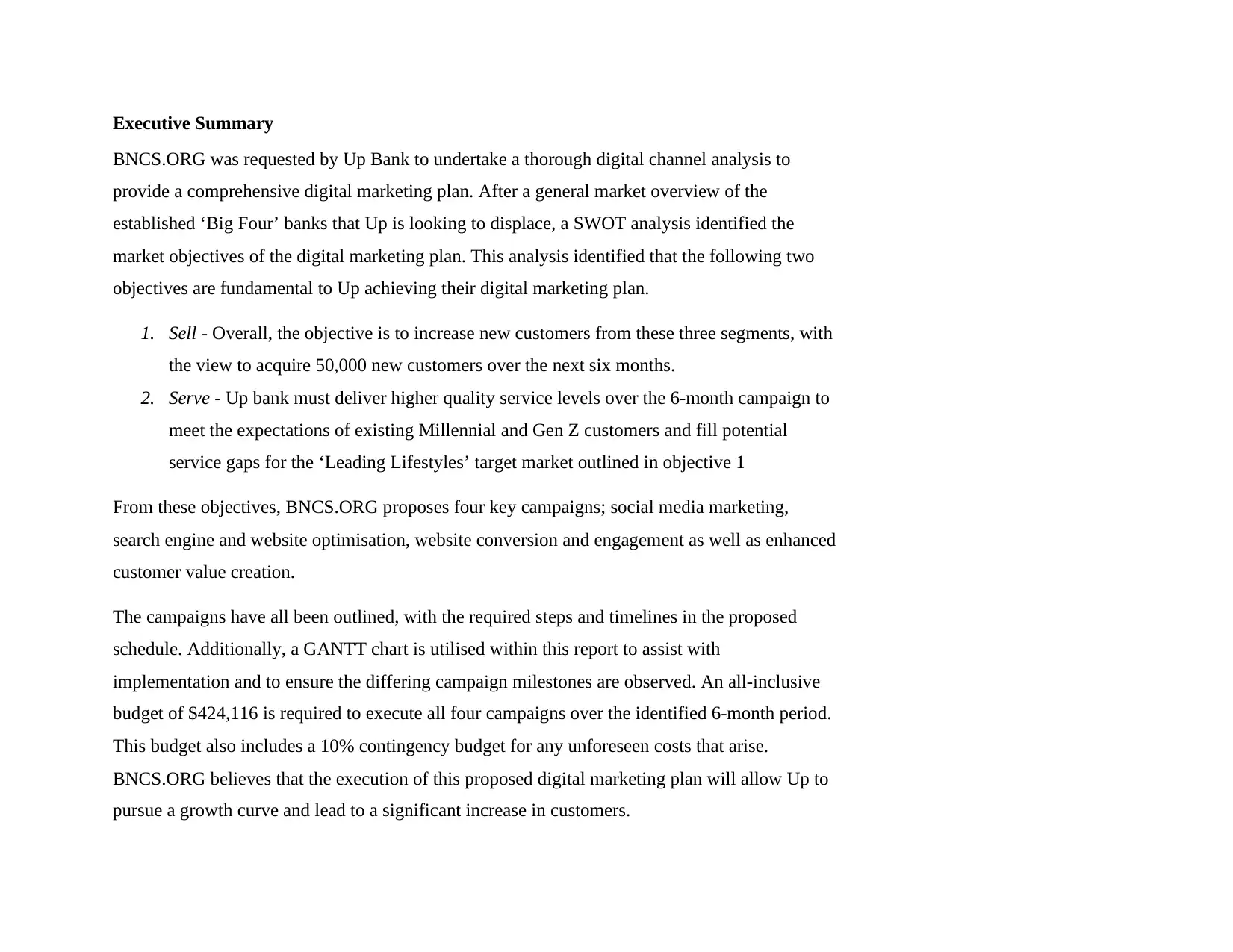
Executive Summary
BNCS.ORG was requested by Up Bank to undertake a thorough digital channel analysis to
provide a comprehensive digital marketing plan. After a general market overview of the
established ‘Big Four’ banks that Up is looking to displace, a SWOT analysis identified the
market objectives of the digital marketing plan. This analysis identified that the following two
objectives are fundamental to Up achieving their digital marketing plan.
1. Sell - Overall, the objective is to increase new customers from these three segments, with
the view to acquire 50,000 new customers over the next six months.
2. Serve - Up bank must deliver higher quality service levels over the 6-month campaign to
meet the expectations of existing Millennial and Gen Z customers and fill potential
service gaps for the ‘Leading Lifestyles’ target market outlined in objective 1
From these objectives, BNCS.ORG proposes four key campaigns; social media marketing,
search engine and website optimisation, website conversion and engagement as well as enhanced
customer value creation.
The campaigns have all been outlined, with the required steps and timelines in the proposed
schedule. Additionally, a GANTT chart is utilised within this report to assist with
implementation and to ensure the differing campaign milestones are observed. An all-inclusive
budget of $424,116 is required to execute all four campaigns over the identified 6-month period.
This budget also includes a 10% contingency budget for any unforeseen costs that arise.
BNCS.ORG believes that the execution of this proposed digital marketing plan will allow Up to
pursue a growth curve and lead to a significant increase in customers.
BNCS.ORG was requested by Up Bank to undertake a thorough digital channel analysis to
provide a comprehensive digital marketing plan. After a general market overview of the
established ‘Big Four’ banks that Up is looking to displace, a SWOT analysis identified the
market objectives of the digital marketing plan. This analysis identified that the following two
objectives are fundamental to Up achieving their digital marketing plan.
1. Sell - Overall, the objective is to increase new customers from these three segments, with
the view to acquire 50,000 new customers over the next six months.
2. Serve - Up bank must deliver higher quality service levels over the 6-month campaign to
meet the expectations of existing Millennial and Gen Z customers and fill potential
service gaps for the ‘Leading Lifestyles’ target market outlined in objective 1
From these objectives, BNCS.ORG proposes four key campaigns; social media marketing,
search engine and website optimisation, website conversion and engagement as well as enhanced
customer value creation.
The campaigns have all been outlined, with the required steps and timelines in the proposed
schedule. Additionally, a GANTT chart is utilised within this report to assist with
implementation and to ensure the differing campaign milestones are observed. An all-inclusive
budget of $424,116 is required to execute all four campaigns over the identified 6-month period.
This budget also includes a 10% contingency budget for any unforeseen costs that arise.
BNCS.ORG believes that the execution of this proposed digital marketing plan will allow Up to
pursue a growth curve and lead to a significant increase in customers.
⊘ This is a preview!⊘
Do you want full access?
Subscribe today to unlock all pages.

Trusted by 1+ million students worldwide
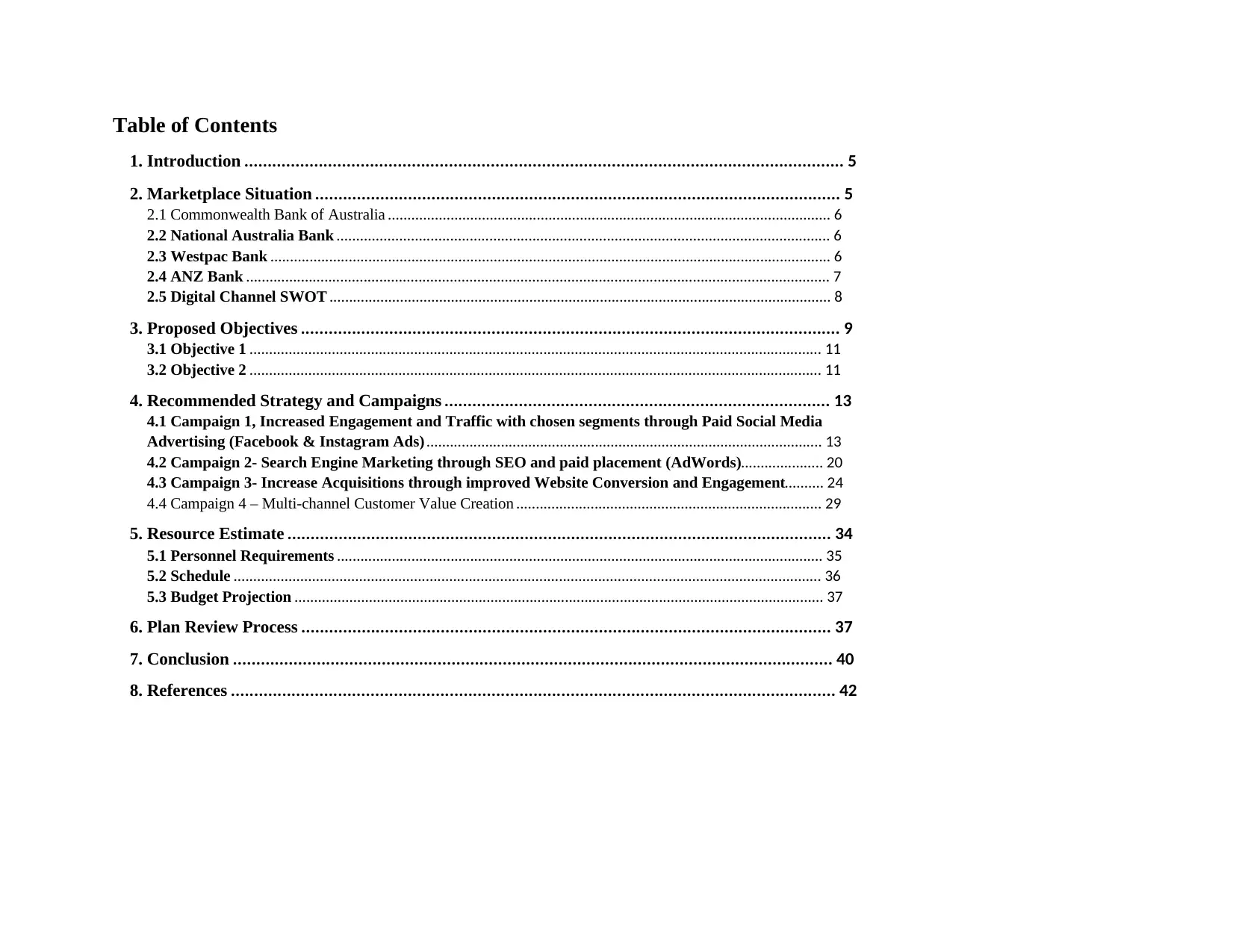
Table of Contents
1. Introduction ................................................................................................................................. 5
2. Marketplace Situation ................................................................................................................. 5
2.1 Commonwealth Bank of Australia ................................................................................................................. 6
2.2 National Australia Bank .............................................................................................................................. 6
2.3 Westpac Bank ............................................................................................................................................... 6
2.4 ANZ Bank ..................................................................................................................................................... 7
2.5 Digital Channel SWOT ................................................................................................................................ 8
3. Proposed Objectives .................................................................................................................... 9
3.1 Objective 1 .................................................................................................................................................. 11
3.2 Objective 2 .................................................................................................................................................. 11
4. Recommended Strategy and Campaigns ................................................................................... 13
4.1 Campaign 1, Increased Engagement and Traffic with chosen segments through Paid Social Media
Advertising (Facebook & Instagram Ads) ..................................................................................................... 13
4.2 Campaign 2- Search Engine Marketing through SEO and paid placement (AdWords)..................... 20
4.3 Campaign 3- Increase Acquisitions through improved Website Conversion and Engagement.......... 24
4.4 Campaign 4 – Multi-channel Customer Value Creation .............................................................................. 29
5. Resource Estimate ..................................................................................................................... 34
5.1 Personnel Requirements ............................................................................................................................ 35
5.2 Schedule ...................................................................................................................................................... 36
5.3 Budget Projection ....................................................................................................................................... 37
6. Plan Review Process .................................................................................................................. 37
7. Conclusion ................................................................................................................................. 40
8. References .................................................................................................................................. 42
1. Introduction ................................................................................................................................. 5
2. Marketplace Situation ................................................................................................................. 5
2.1 Commonwealth Bank of Australia ................................................................................................................. 6
2.2 National Australia Bank .............................................................................................................................. 6
2.3 Westpac Bank ............................................................................................................................................... 6
2.4 ANZ Bank ..................................................................................................................................................... 7
2.5 Digital Channel SWOT ................................................................................................................................ 8
3. Proposed Objectives .................................................................................................................... 9
3.1 Objective 1 .................................................................................................................................................. 11
3.2 Objective 2 .................................................................................................................................................. 11
4. Recommended Strategy and Campaigns ................................................................................... 13
4.1 Campaign 1, Increased Engagement and Traffic with chosen segments through Paid Social Media
Advertising (Facebook & Instagram Ads) ..................................................................................................... 13
4.2 Campaign 2- Search Engine Marketing through SEO and paid placement (AdWords)..................... 20
4.3 Campaign 3- Increase Acquisitions through improved Website Conversion and Engagement.......... 24
4.4 Campaign 4 – Multi-channel Customer Value Creation .............................................................................. 29
5. Resource Estimate ..................................................................................................................... 34
5.1 Personnel Requirements ............................................................................................................................ 35
5.2 Schedule ...................................................................................................................................................... 36
5.3 Budget Projection ....................................................................................................................................... 37
6. Plan Review Process .................................................................................................................. 37
7. Conclusion ................................................................................................................................. 40
8. References .................................................................................................................................. 42
Paraphrase This Document
Need a fresh take? Get an instant paraphrase of this document with our AI Paraphraser
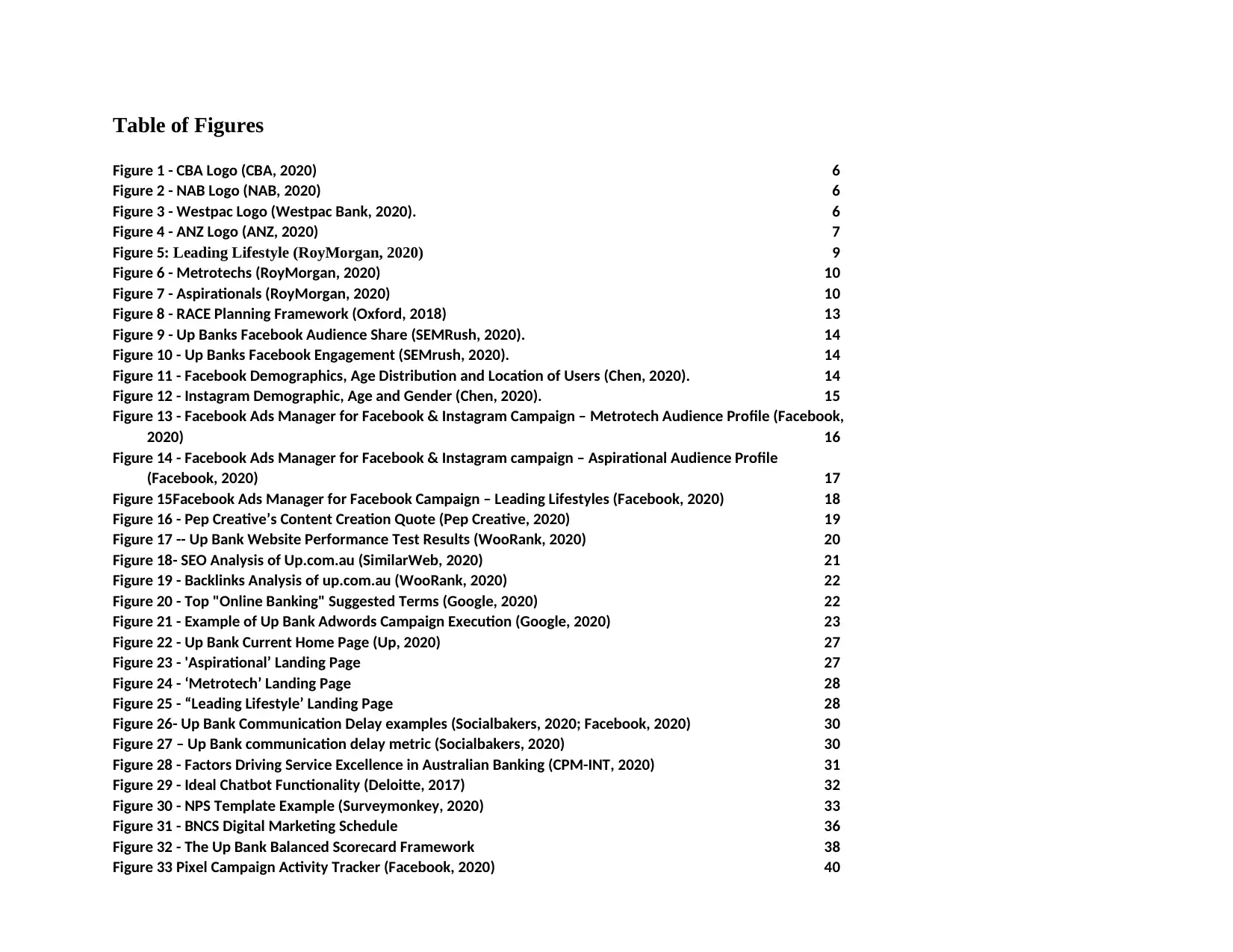
Table of Figures
Figure 1 - CBA Logo (CBA, 2020) 6
Figure 2 - NAB Logo (NAB, 2020) 6
Figure 3 - Westpac Logo (Westpac Bank, 2020). 6
Figure 4 - ANZ Logo (ANZ, 2020) 7
Figure 5: Leading Lifestyle (RoyMorgan, 2020) 9
Figure 6 - Metrotechs (RoyMorgan, 2020) 10
Figure 7 - Aspirationals (RoyMorgan, 2020) 10
Figure 8 - RACE Planning Framework (Oxford, 2018) 13
Figure 9 - Up Banks Facebook Audience Share (SEMRush, 2020). 14
Figure 10 - Up Banks Facebook Engagement (SEMrush, 2020). 14
Figure 11 - Facebook Demographics, Age Distribution and Location of Users (Chen, 2020). 14
Figure 12 - Instagram Demographic, Age and Gender (Chen, 2020). 15
Figure 13 - Facebook Ads Manager for Facebook & Instagram Campaign – Metrotech Audience Profile (Facebook,
2020) 16
Figure 14 - Facebook Ads Manager for Facebook & Instagram campaign – Aspirational Audience Profile
(Facebook, 2020) 17
Figure 15Facebook Ads Manager for Facebook Campaign – Leading Lifestyles (Facebook, 2020) 18
Figure 16 - Pep Creative’s Content Creation Quote (Pep Creative, 2020) 19
Figure 17 -- Up Bank Website Performance Test Results (WooRank, 2020) 20
Figure 18- SEO Analysis of Up.com.au (SimilarWeb, 2020) 21
Figure 19 - Backlinks Analysis of up.com.au (WooRank, 2020) 22
Figure 20 - Top "Online Banking" Suggested Terms (Google, 2020) 22
Figure 21 - Example of Up Bank Adwords Campaign Execution (Google, 2020) 23
Figure 22 - Up Bank Current Home Page (Up, 2020) 27
Figure 23 - 'Aspirational’ Landing Page 27
Figure 24 - ‘Metrotech’ Landing Page 28
Figure 25 - “Leading Lifestyle’ Landing Page 28
Figure 26- Up Bank Communication Delay examples (Socialbakers, 2020; Facebook, 2020) 30
Figure 27 – Up Bank communication delay metric (Socialbakers, 2020) 30
Figure 28 - Factors Driving Service Excellence in Australian Banking (CPM-INT, 2020) 31
Figure 29 - Ideal Chatbot Functionality (Deloitte, 2017) 32
Figure 30 - NPS Template Example (Surveymonkey, 2020) 33
Figure 31 - BNCS Digital Marketing Schedule 36
Figure 32 - The Up Bank Balanced Scorecard Framework 38
Figure 33 Pixel Campaign Activity Tracker (Facebook, 2020) 40
Figure 1 - CBA Logo (CBA, 2020) 6
Figure 2 - NAB Logo (NAB, 2020) 6
Figure 3 - Westpac Logo (Westpac Bank, 2020). 6
Figure 4 - ANZ Logo (ANZ, 2020) 7
Figure 5: Leading Lifestyle (RoyMorgan, 2020) 9
Figure 6 - Metrotechs (RoyMorgan, 2020) 10
Figure 7 - Aspirationals (RoyMorgan, 2020) 10
Figure 8 - RACE Planning Framework (Oxford, 2018) 13
Figure 9 - Up Banks Facebook Audience Share (SEMRush, 2020). 14
Figure 10 - Up Banks Facebook Engagement (SEMrush, 2020). 14
Figure 11 - Facebook Demographics, Age Distribution and Location of Users (Chen, 2020). 14
Figure 12 - Instagram Demographic, Age and Gender (Chen, 2020). 15
Figure 13 - Facebook Ads Manager for Facebook & Instagram Campaign – Metrotech Audience Profile (Facebook,
2020) 16
Figure 14 - Facebook Ads Manager for Facebook & Instagram campaign – Aspirational Audience Profile
(Facebook, 2020) 17
Figure 15Facebook Ads Manager for Facebook Campaign – Leading Lifestyles (Facebook, 2020) 18
Figure 16 - Pep Creative’s Content Creation Quote (Pep Creative, 2020) 19
Figure 17 -- Up Bank Website Performance Test Results (WooRank, 2020) 20
Figure 18- SEO Analysis of Up.com.au (SimilarWeb, 2020) 21
Figure 19 - Backlinks Analysis of up.com.au (WooRank, 2020) 22
Figure 20 - Top "Online Banking" Suggested Terms (Google, 2020) 22
Figure 21 - Example of Up Bank Adwords Campaign Execution (Google, 2020) 23
Figure 22 - Up Bank Current Home Page (Up, 2020) 27
Figure 23 - 'Aspirational’ Landing Page 27
Figure 24 - ‘Metrotech’ Landing Page 28
Figure 25 - “Leading Lifestyle’ Landing Page 28
Figure 26- Up Bank Communication Delay examples (Socialbakers, 2020; Facebook, 2020) 30
Figure 27 – Up Bank communication delay metric (Socialbakers, 2020) 30
Figure 28 - Factors Driving Service Excellence in Australian Banking (CPM-INT, 2020) 31
Figure 29 - Ideal Chatbot Functionality (Deloitte, 2017) 32
Figure 30 - NPS Template Example (Surveymonkey, 2020) 33
Figure 31 - BNCS Digital Marketing Schedule 36
Figure 32 - The Up Bank Balanced Scorecard Framework 38
Figure 33 Pixel Campaign Activity Tracker (Facebook, 2020) 40
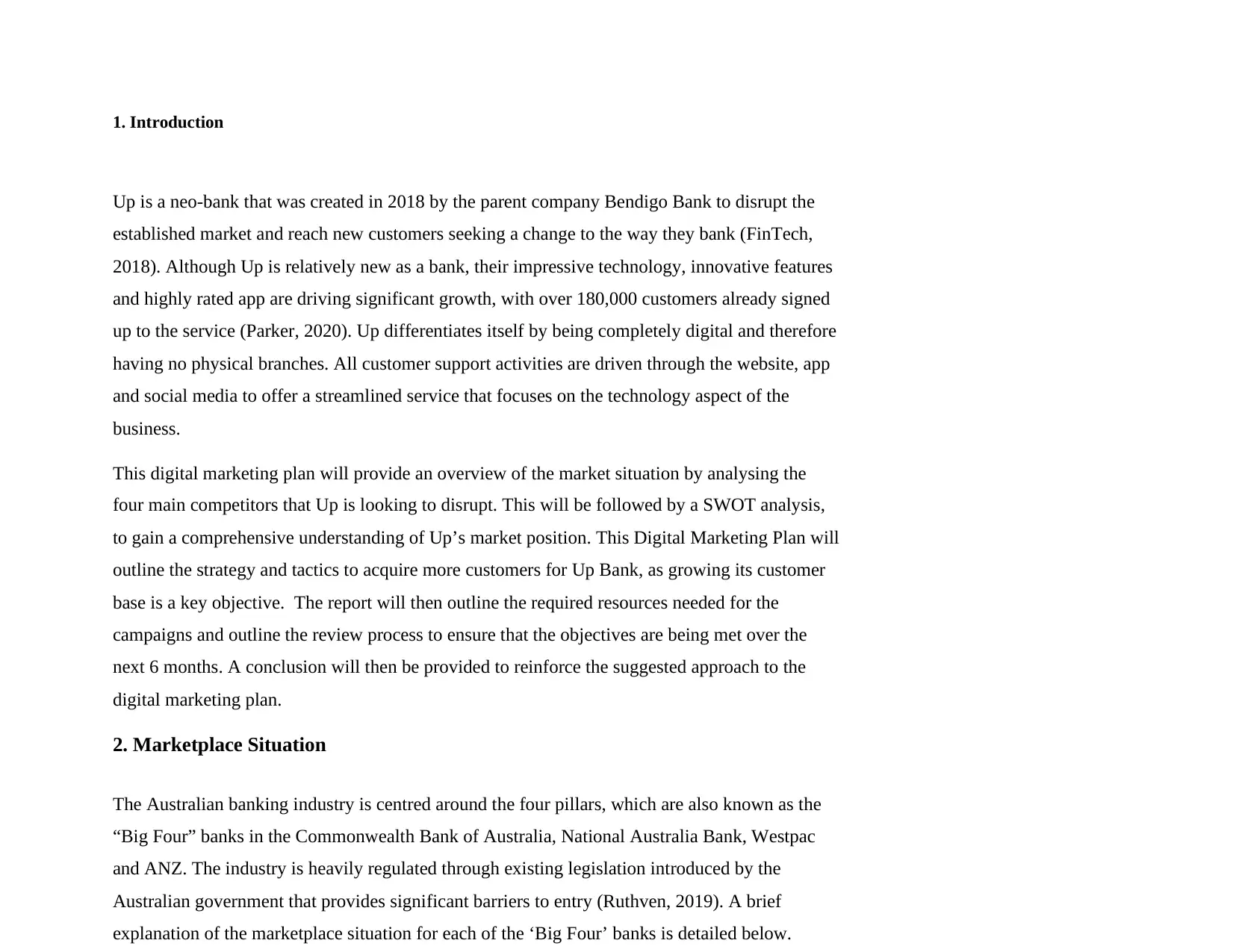
1. Introduction
Up is a neo-bank that was created in 2018 by the parent company Bendigo Bank to disrupt the
established market and reach new customers seeking a change to the way they bank (FinTech,
2018). Although Up is relatively new as a bank, their impressive technology, innovative features
and highly rated app are driving significant growth, with over 180,000 customers already signed
up to the service (Parker, 2020). Up differentiates itself by being completely digital and therefore
having no physical branches. All customer support activities are driven through the website, app
and social media to offer a streamlined service that focuses on the technology aspect of the
business.
This digital marketing plan will provide an overview of the market situation by analysing the
four main competitors that Up is looking to disrupt. This will be followed by a SWOT analysis,
to gain a comprehensive understanding of Up’s market position. This Digital Marketing Plan will
outline the strategy and tactics to acquire more customers for Up Bank, as growing its customer
base is a key objective. The report will then outline the required resources needed for the
campaigns and outline the review process to ensure that the objectives are being met over the
next 6 months. A conclusion will then be provided to reinforce the suggested approach to the
digital marketing plan.
2. Marketplace Situation
The Australian banking industry is centred around the four pillars, which are also known as the
“Big Four” banks in the Commonwealth Bank of Australia, National Australia Bank, Westpac
and ANZ. The industry is heavily regulated through existing legislation introduced by the
Australian government that provides significant barriers to entry (Ruthven, 2019). A brief
explanation of the marketplace situation for each of the ‘Big Four’ banks is detailed below.
Up is a neo-bank that was created in 2018 by the parent company Bendigo Bank to disrupt the
established market and reach new customers seeking a change to the way they bank (FinTech,
2018). Although Up is relatively new as a bank, their impressive technology, innovative features
and highly rated app are driving significant growth, with over 180,000 customers already signed
up to the service (Parker, 2020). Up differentiates itself by being completely digital and therefore
having no physical branches. All customer support activities are driven through the website, app
and social media to offer a streamlined service that focuses on the technology aspect of the
business.
This digital marketing plan will provide an overview of the market situation by analysing the
four main competitors that Up is looking to disrupt. This will be followed by a SWOT analysis,
to gain a comprehensive understanding of Up’s market position. This Digital Marketing Plan will
outline the strategy and tactics to acquire more customers for Up Bank, as growing its customer
base is a key objective. The report will then outline the required resources needed for the
campaigns and outline the review process to ensure that the objectives are being met over the
next 6 months. A conclusion will then be provided to reinforce the suggested approach to the
digital marketing plan.
2. Marketplace Situation
The Australian banking industry is centred around the four pillars, which are also known as the
“Big Four” banks in the Commonwealth Bank of Australia, National Australia Bank, Westpac
and ANZ. The industry is heavily regulated through existing legislation introduced by the
Australian government that provides significant barriers to entry (Ruthven, 2019). A brief
explanation of the marketplace situation for each of the ‘Big Four’ banks is detailed below.
⊘ This is a preview!⊘
Do you want full access?
Subscribe today to unlock all pages.

Trusted by 1+ million students worldwide
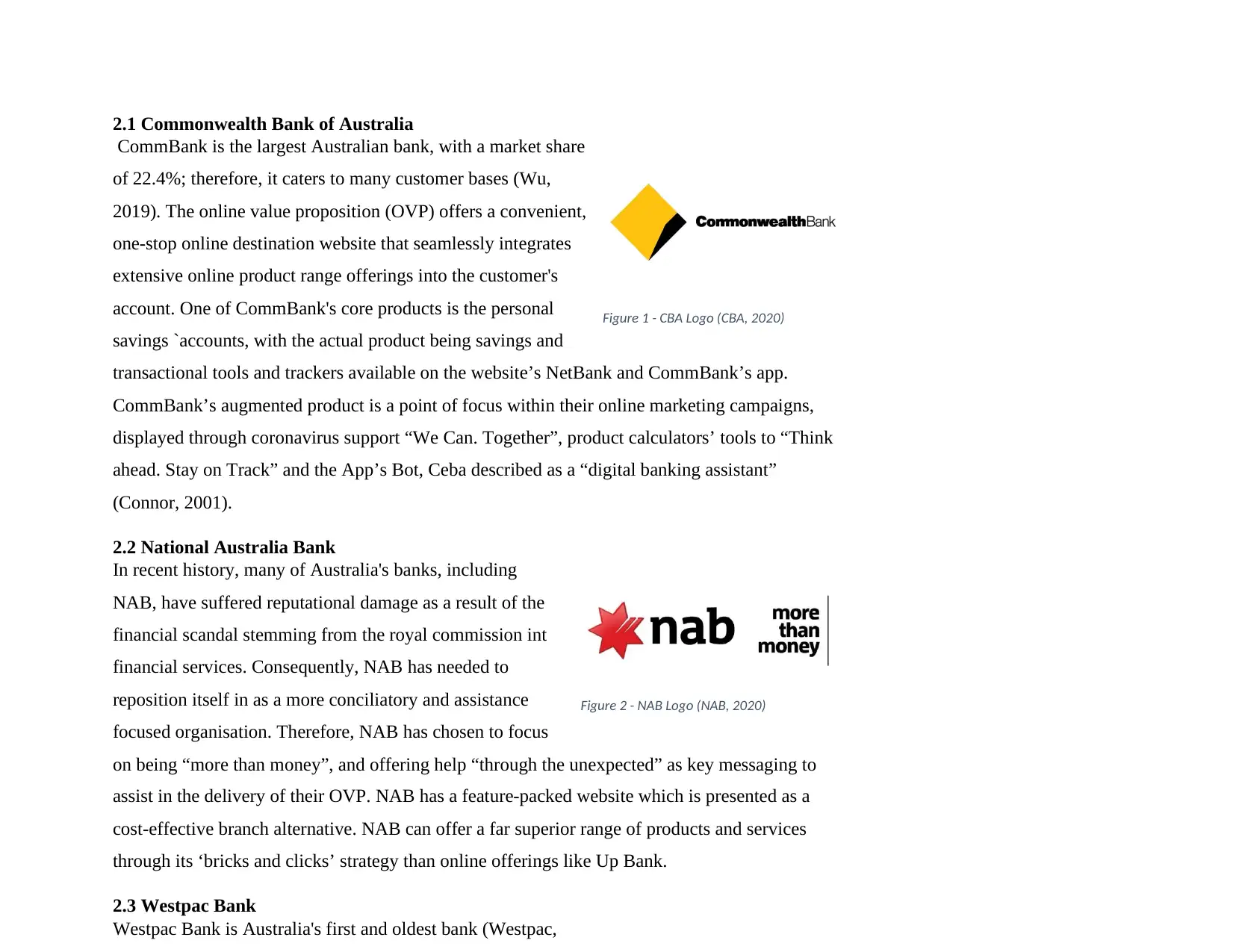
2.1 Commonwealth Bank of Australia
CommBank is the largest Australian bank, with a market share
of 22.4%; therefore, it caters to many customer bases (Wu,
2019). The online value proposition (OVP) offers a convenient,
one-stop online destination website that seamlessly integrates
extensive online product range offerings into the customer's
account. One of CommBank's core products is the personal
savings `accounts, with the actual product being savings and
transactional tools and trackers available on the website’s NetBank and CommBank’s app.
CommBank’s augmented product is a point of focus within their online marketing campaigns,
displayed through coronavirus support “We Can. Together”, product calculators’ tools to “Think
ahead. Stay on Track” and the App’s Bot, Ceba described as a “digital banking assistant”
(Connor, 2001).
2.2 National Australia Bank
In recent history, many of Australia's banks, including
NAB, have suffered reputational damage as a result of the
financial scandal stemming from the royal commission into
financial services. Consequently, NAB has needed to
reposition itself in as a more conciliatory and assistance
focused organisation. Therefore, NAB has chosen to focus
on being “more than money”, and offering help “through the unexpected” as key messaging to
assist in the delivery of their OVP. NAB has a feature-packed website which is presented as a
cost-effective branch alternative. NAB can offer a far superior range of products and services
through its ‘bricks and clicks’ strategy than online offerings like Up Bank.
2.3 Westpac Bank
Westpac Bank is Australia's first and oldest bank (Westpac,
Figure 1 - CBA Logo (CBA, 2020)
Figure 2 - NAB Logo (NAB, 2020)
CommBank is the largest Australian bank, with a market share
of 22.4%; therefore, it caters to many customer bases (Wu,
2019). The online value proposition (OVP) offers a convenient,
one-stop online destination website that seamlessly integrates
extensive online product range offerings into the customer's
account. One of CommBank's core products is the personal
savings `accounts, with the actual product being savings and
transactional tools and trackers available on the website’s NetBank and CommBank’s app.
CommBank’s augmented product is a point of focus within their online marketing campaigns,
displayed through coronavirus support “We Can. Together”, product calculators’ tools to “Think
ahead. Stay on Track” and the App’s Bot, Ceba described as a “digital banking assistant”
(Connor, 2001).
2.2 National Australia Bank
In recent history, many of Australia's banks, including
NAB, have suffered reputational damage as a result of the
financial scandal stemming from the royal commission into
financial services. Consequently, NAB has needed to
reposition itself in as a more conciliatory and assistance
focused organisation. Therefore, NAB has chosen to focus
on being “more than money”, and offering help “through the unexpected” as key messaging to
assist in the delivery of their OVP. NAB has a feature-packed website which is presented as a
cost-effective branch alternative. NAB can offer a far superior range of products and services
through its ‘bricks and clicks’ strategy than online offerings like Up Bank.
2.3 Westpac Bank
Westpac Bank is Australia's first and oldest bank (Westpac,
Figure 1 - CBA Logo (CBA, 2020)
Figure 2 - NAB Logo (NAB, 2020)
Paraphrase This Document
Need a fresh take? Get an instant paraphrase of this document with our AI Paraphraser
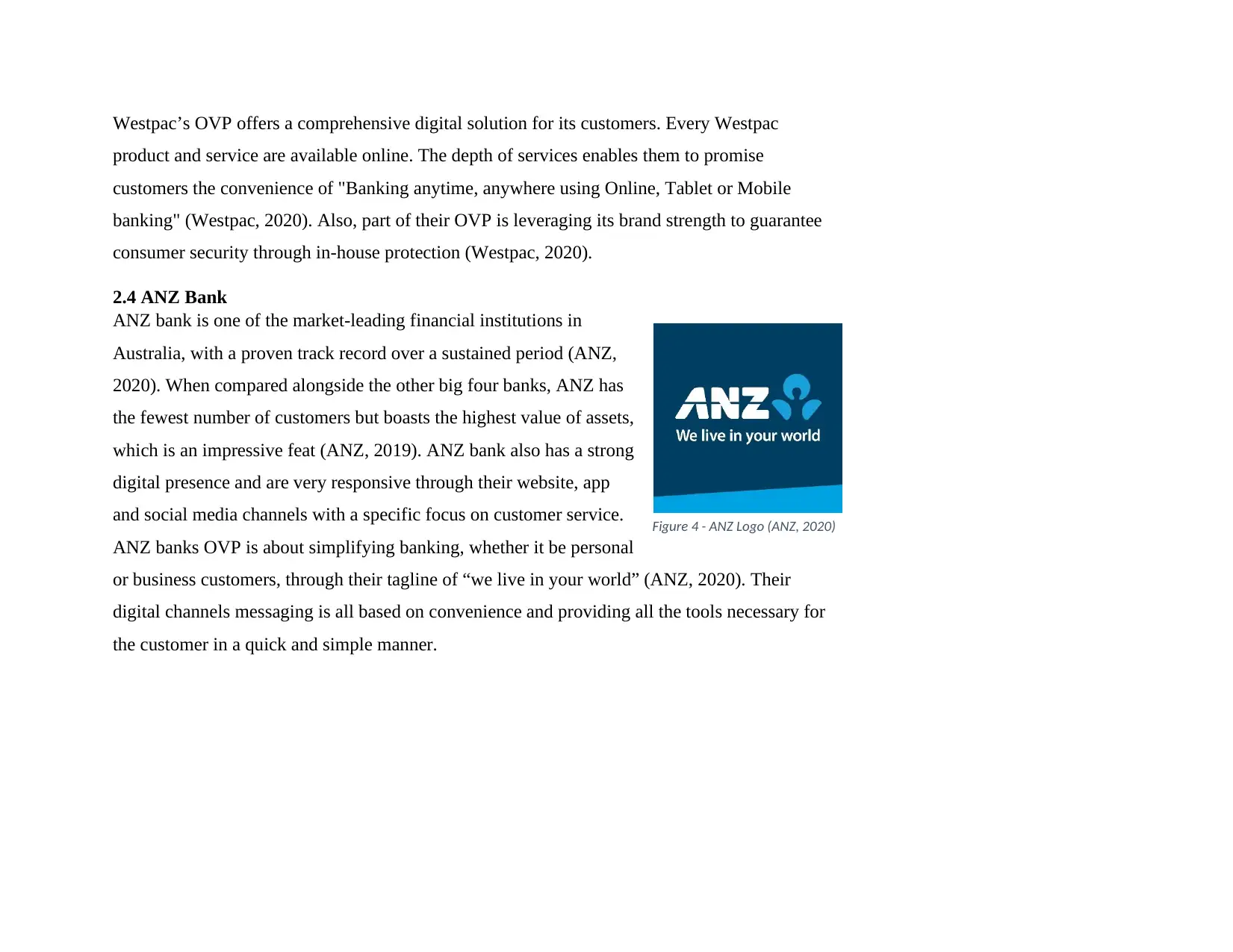
Westpac’s OVP offers a comprehensive digital solution for its customers. Every Westpac
product and service are available online. The depth of services enables them to promise
customers the convenience of "Banking anytime, anywhere using Online, Tablet or Mobile
banking" (Westpac, 2020). Also, part of their OVP is leveraging its brand strength to guarantee
consumer security through in-house protection (Westpac, 2020).
2.4 ANZ Bank
ANZ bank is one of the market-leading financial institutions in
Australia, with a proven track record over a sustained period (ANZ,
2020). When compared alongside the other big four banks, ANZ has
the fewest number of customers but boasts the highest value of assets,
which is an impressive feat (ANZ, 2019). ANZ bank also has a strong
digital presence and are very responsive through their website, app
and social media channels with a specific focus on customer service.
ANZ banks OVP is about simplifying banking, whether it be personal
or business customers, through their tagline of “we live in your world” (ANZ, 2020). Their
digital channels messaging is all based on convenience and providing all the tools necessary for
the customer in a quick and simple manner.
Figure 4 - ANZ Logo (ANZ, 2020)
product and service are available online. The depth of services enables them to promise
customers the convenience of "Banking anytime, anywhere using Online, Tablet or Mobile
banking" (Westpac, 2020). Also, part of their OVP is leveraging its brand strength to guarantee
consumer security through in-house protection (Westpac, 2020).
2.4 ANZ Bank
ANZ bank is one of the market-leading financial institutions in
Australia, with a proven track record over a sustained period (ANZ,
2020). When compared alongside the other big four banks, ANZ has
the fewest number of customers but boasts the highest value of assets,
which is an impressive feat (ANZ, 2019). ANZ bank also has a strong
digital presence and are very responsive through their website, app
and social media channels with a specific focus on customer service.
ANZ banks OVP is about simplifying banking, whether it be personal
or business customers, through their tagline of “we live in your world” (ANZ, 2020). Their
digital channels messaging is all based on convenience and providing all the tools necessary for
the customer in a quick and simple manner.
Figure 4 - ANZ Logo (ANZ, 2020)
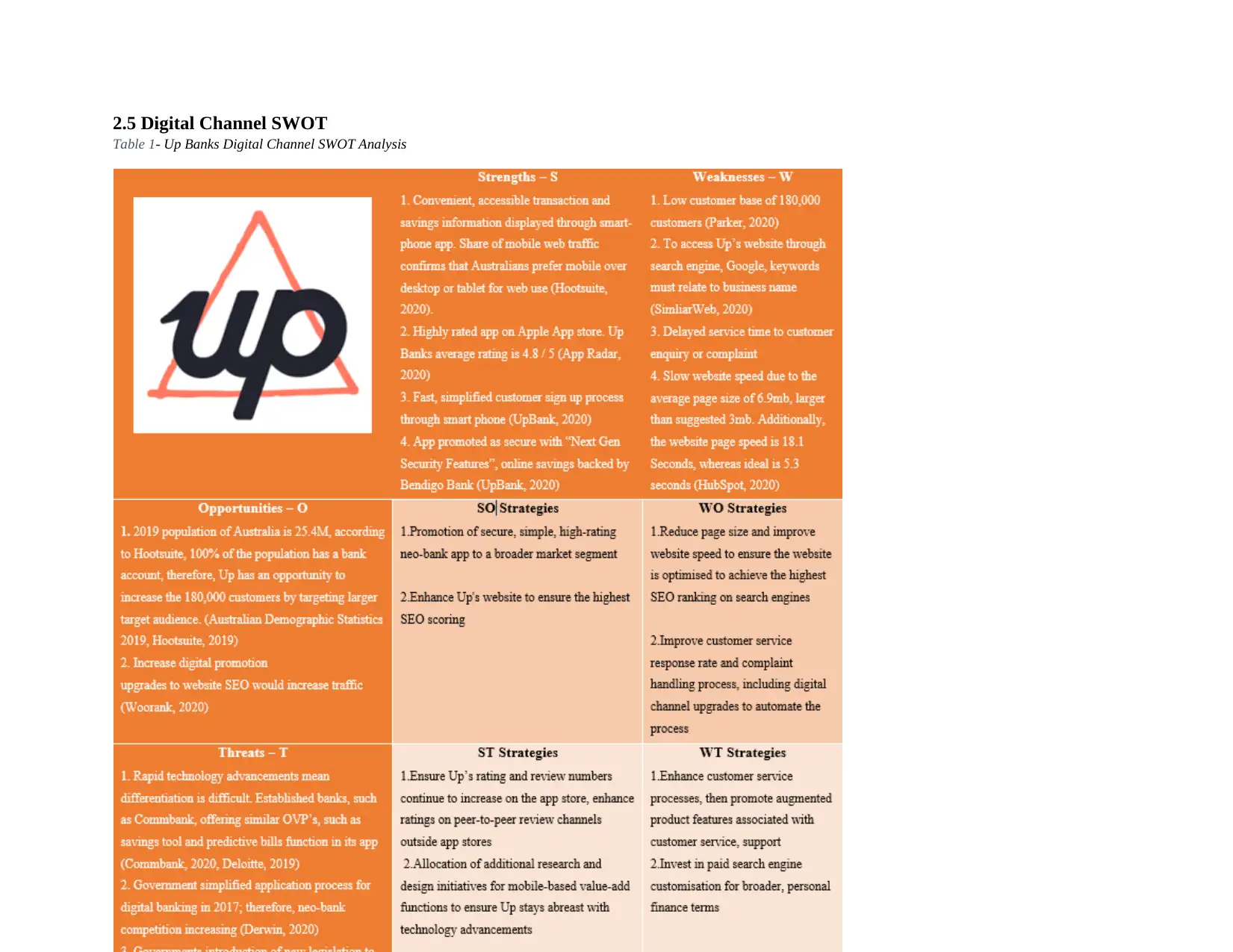
2.5 Digital Channel SWOT
Table 1- Up Banks Digital Channel SWOT Analysis
Table 1- Up Banks Digital Channel SWOT Analysis
⊘ This is a preview!⊘
Do you want full access?
Subscribe today to unlock all pages.

Trusted by 1+ million students worldwide
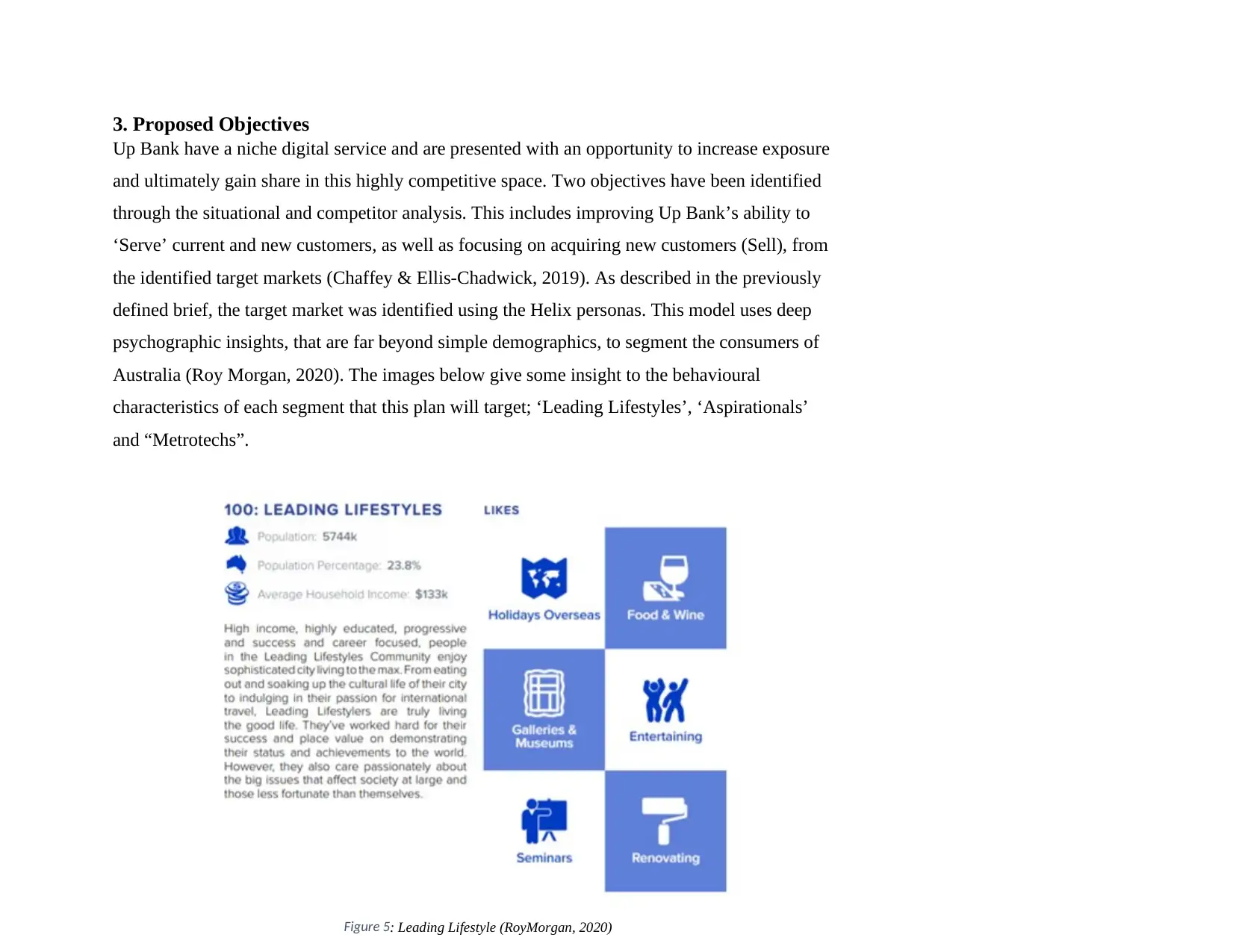
3. Proposed Objectives
Up Bank have a niche digital service and are presented with an opportunity to increase exposure
and ultimately gain share in this highly competitive space. Two objectives have been identified
through the situational and competitor analysis. This includes improving Up Bank’s ability to
‘Serve’ current and new customers, as well as focusing on acquiring new customers (Sell), from
the identified target markets (Chaffey & Ellis-Chadwick, 2019). As described in the previously
defined brief, the target market was identified using the Helix personas. This model uses deep
psychographic insights, that are far beyond simple demographics, to segment the consumers of
Australia (Roy Morgan, 2020). The images below give some insight to the behavioural
characteristics of each segment that this plan will target; ‘Leading Lifestyles’, ‘Aspirationals’
and “Metrotechs”.
Figure 5: Leading Lifestyle (RoyMorgan, 2020)
Up Bank have a niche digital service and are presented with an opportunity to increase exposure
and ultimately gain share in this highly competitive space. Two objectives have been identified
through the situational and competitor analysis. This includes improving Up Bank’s ability to
‘Serve’ current and new customers, as well as focusing on acquiring new customers (Sell), from
the identified target markets (Chaffey & Ellis-Chadwick, 2019). As described in the previously
defined brief, the target market was identified using the Helix personas. This model uses deep
psychographic insights, that are far beyond simple demographics, to segment the consumers of
Australia (Roy Morgan, 2020). The images below give some insight to the behavioural
characteristics of each segment that this plan will target; ‘Leading Lifestyles’, ‘Aspirationals’
and “Metrotechs”.
Figure 5: Leading Lifestyle (RoyMorgan, 2020)
Paraphrase This Document
Need a fresh take? Get an instant paraphrase of this document with our AI Paraphraser
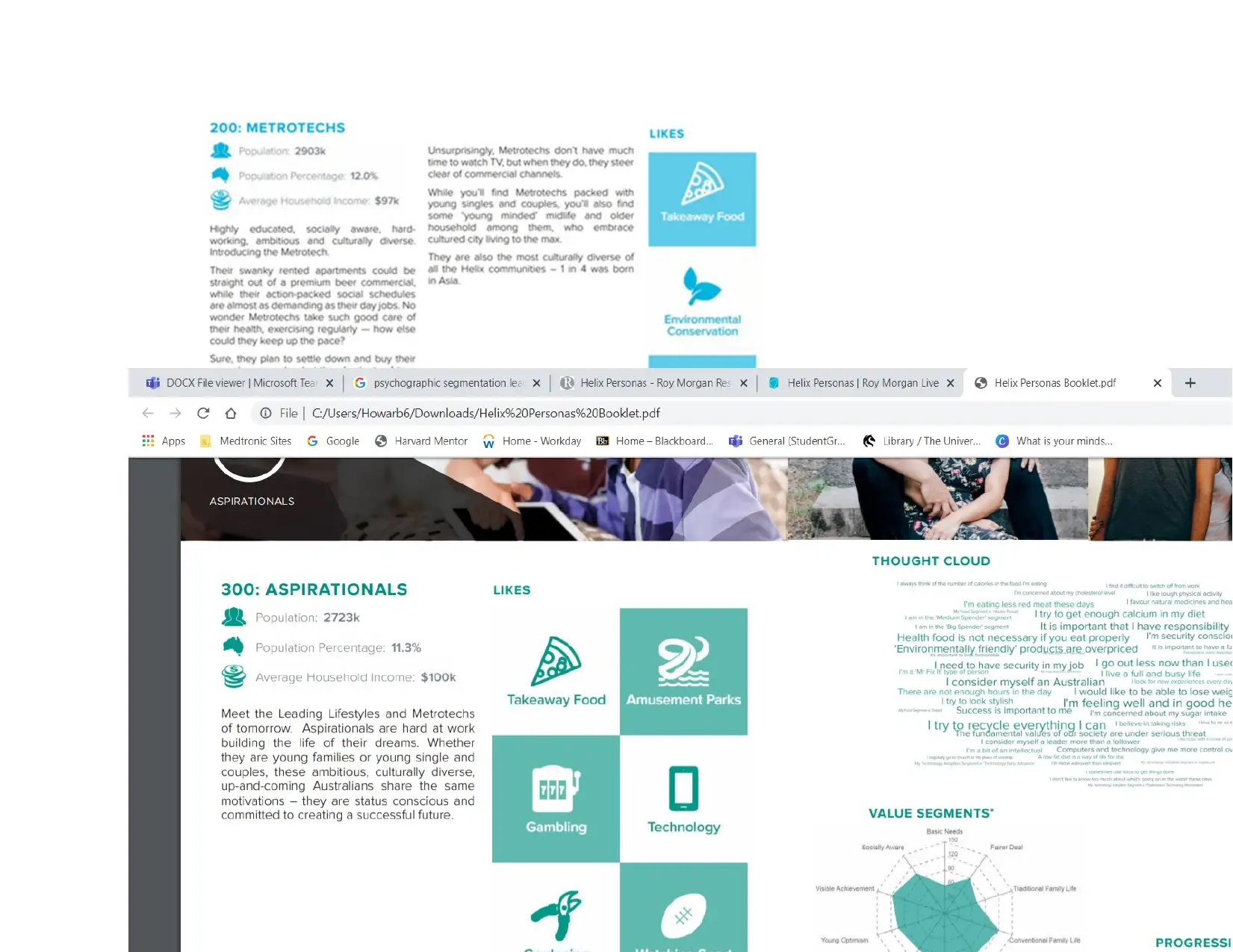
Figure 6 - Metrotechs (RoyMorgan, 2020)
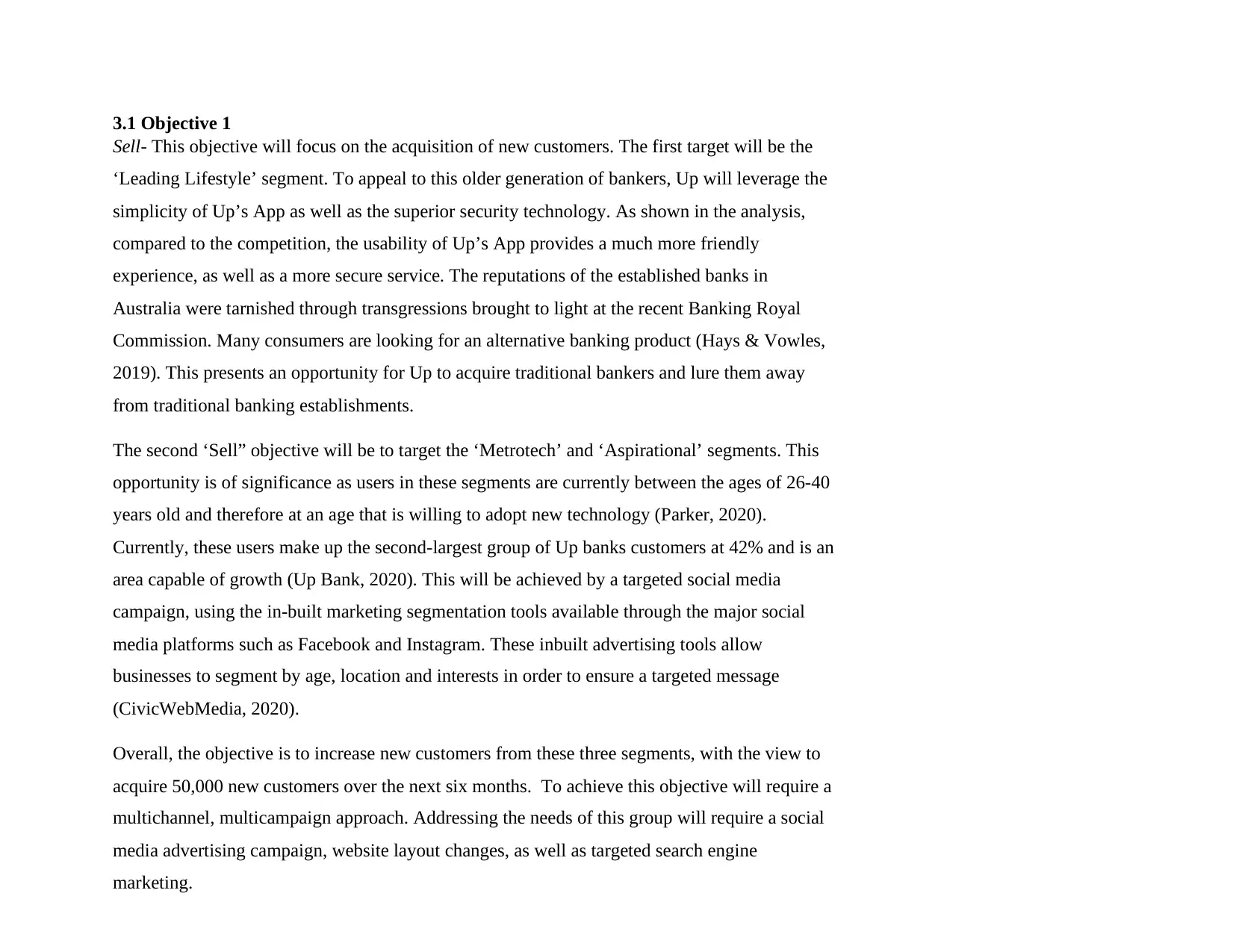
3.1 Objective 1
Sell- This objective will focus on the acquisition of new customers. The first target will be the
‘Leading Lifestyle’ segment. To appeal to this older generation of bankers, Up will leverage the
simplicity of Up’s App as well as the superior security technology. As shown in the analysis,
compared to the competition, the usability of Up’s App provides a much more friendly
experience, as well as a more secure service. The reputations of the established banks in
Australia were tarnished through transgressions brought to light at the recent Banking Royal
Commission. Many consumers are looking for an alternative banking product (Hays & Vowles,
2019). This presents an opportunity for Up to acquire traditional bankers and lure them away
from traditional banking establishments.
The second ‘Sell” objective will be to target the ‘Metrotech’ and ‘Aspirational’ segments. This
opportunity is of significance as users in these segments are currently between the ages of 26-40
years old and therefore at an age that is willing to adopt new technology (Parker, 2020).
Currently, these users make up the second-largest group of Up banks customers at 42% and is an
area capable of growth (Up Bank, 2020). This will be achieved by a targeted social media
campaign, using the in-built marketing segmentation tools available through the major social
media platforms such as Facebook and Instagram. These inbuilt advertising tools allow
businesses to segment by age, location and interests in order to ensure a targeted message
(CivicWebMedia, 2020).
Overall, the objective is to increase new customers from these three segments, with the view to
acquire 50,000 new customers over the next six months. To achieve this objective will require a
multichannel, multicampaign approach. Addressing the needs of this group will require a social
media advertising campaign, website layout changes, as well as targeted search engine
marketing.
Sell- This objective will focus on the acquisition of new customers. The first target will be the
‘Leading Lifestyle’ segment. To appeal to this older generation of bankers, Up will leverage the
simplicity of Up’s App as well as the superior security technology. As shown in the analysis,
compared to the competition, the usability of Up’s App provides a much more friendly
experience, as well as a more secure service. The reputations of the established banks in
Australia were tarnished through transgressions brought to light at the recent Banking Royal
Commission. Many consumers are looking for an alternative banking product (Hays & Vowles,
2019). This presents an opportunity for Up to acquire traditional bankers and lure them away
from traditional banking establishments.
The second ‘Sell” objective will be to target the ‘Metrotech’ and ‘Aspirational’ segments. This
opportunity is of significance as users in these segments are currently between the ages of 26-40
years old and therefore at an age that is willing to adopt new technology (Parker, 2020).
Currently, these users make up the second-largest group of Up banks customers at 42% and is an
area capable of growth (Up Bank, 2020). This will be achieved by a targeted social media
campaign, using the in-built marketing segmentation tools available through the major social
media platforms such as Facebook and Instagram. These inbuilt advertising tools allow
businesses to segment by age, location and interests in order to ensure a targeted message
(CivicWebMedia, 2020).
Overall, the objective is to increase new customers from these three segments, with the view to
acquire 50,000 new customers over the next six months. To achieve this objective will require a
multichannel, multicampaign approach. Addressing the needs of this group will require a social
media advertising campaign, website layout changes, as well as targeted search engine
marketing.
⊘ This is a preview!⊘
Do you want full access?
Subscribe today to unlock all pages.

Trusted by 1+ million students worldwide
1 out of 48
Related Documents
Your All-in-One AI-Powered Toolkit for Academic Success.
+13062052269
info@desklib.com
Available 24*7 on WhatsApp / Email
![[object Object]](/_next/static/media/star-bottom.7253800d.svg)
Unlock your academic potential
Copyright © 2020–2025 A2Z Services. All Rights Reserved. Developed and managed by ZUCOL.





